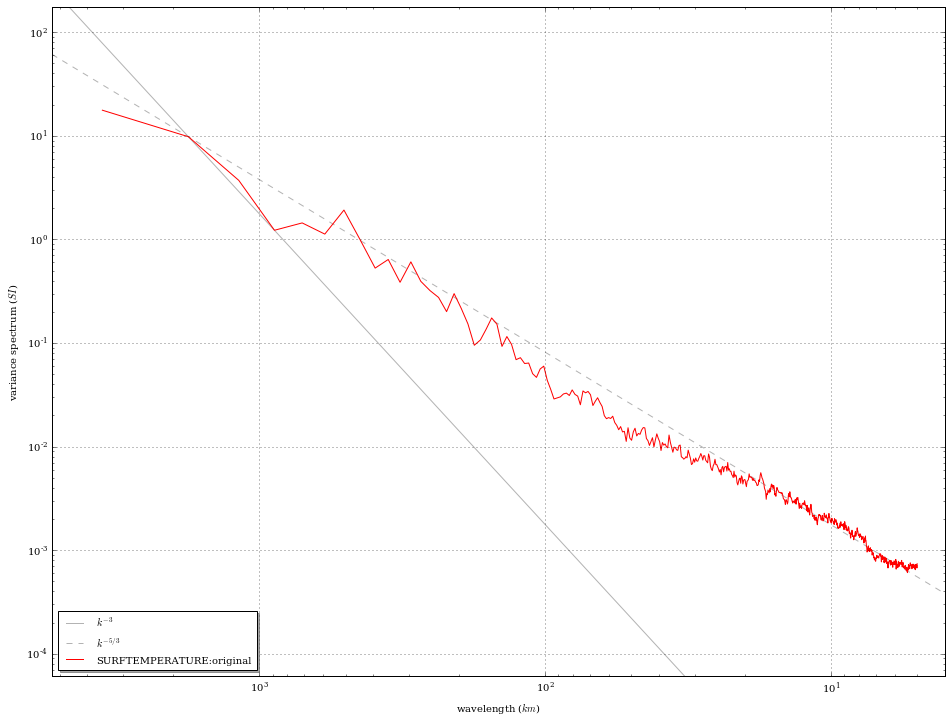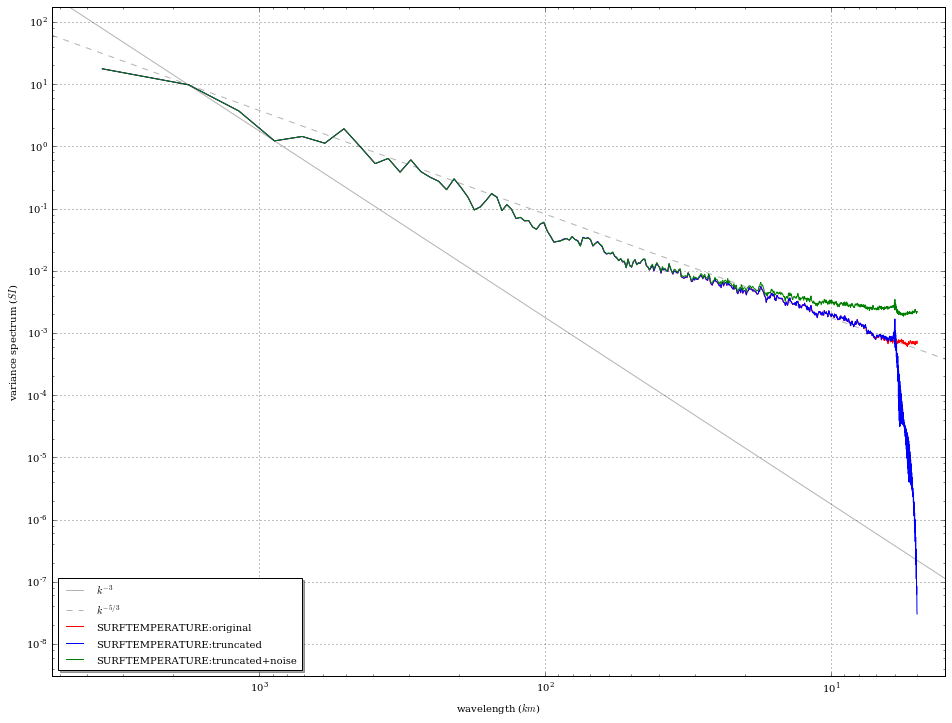5.2. Hacking fields…¶
Read a field, cut the smallest wavelength in spectral space, add some noise… or any other change !
[1]:
%matplotlib inline
import os
import epygram
epygram.init_env()
workdir = epygram.config.userlocaldir + '/notebooks_data'
os.chdir(workdir)
import numpy
[2]:
r = epygram.formats.resource('advanced_examples/ICMSHAROM+0001', 'r')
r_out = epygram.formats.resource('advanced_examples/ICMSHAROM+0001_bis', 'a') # 'a' == r/w
[3]:
orog = r.readfield('SPECSURFGEOPOTEN')
orog.spectral
[3]:
True
[4]:
t2m = r.readfield('SURFTEMPERATURE')
t2m.spectral
[4]:
False
[5]:
t2m_spectrum1 = t2m.dctspectrum(subzone='CI') # compute its DCT spectrum
t2m_spectrum1.name = 'SURFTEMPERATURE:original'
t2m_spectrum1.plotspectrum()
[5]:
(<matplotlib.figure.Figure at 0x7f5c0179fb10>,
<matplotlib.axes._subplots.AxesSubplot at 0x7f5c01770e90>)

Now let’s cut the smallest wavelengths
[6]:
print(orog.spectral_geometry)
SpectralGeometry containing:
truncation:
in_X: 374
in_Y: 359
shape: elliptic
space: bi-fourier
[7]:
# let's make a modified, truncated geometry
truncated_geom = orog.spectral_geometry.deepcopy()
truncated_geom.truncation['in_X'] = 320
truncated_geom.truncation['in_Y'] = 300
[8]:
# spectral round-trip on the truncated geometry
t2m.gp2sp(truncated_geom)
t2m.sp2gp()
[9]:
t2m_spectrum2 = t2m.dctspectrum(subzone='CI') # compute the new spectrum
t2m_spectrum2.name = 'SURFTEMPERATURE:truncated'
And finally let’s get a 3rd field, truncated, with some noise added on…
[10]:
t2m.geometry.dimensions
[10]:
{u'X': 750,
u'X_CIoffset': 0,
u'X_CIzone': 739,
u'X_Czone': 723,
u'X_Iwidth': 8,
u'Y': 720,
u'Y_CIoffset': 0,
u'Y_CIzone': 709,
u'Y_Czone': 693,
u'Y_Iwidth': 8}
[11]:
noise = numpy.random.normal(0, size=(t2m.geometry.dimensions['Y_CIzone'],
t2m.geometry.dimensions['X_CIzone']))
[12]:
fdata = t2m.getdata()
fdata[:t2m.geometry.dimensions['Y_CIzone'],
:t2m.geometry.dimensions['X_CIzone']] += noise
[13]:
t2m.setdata(fdata) # update the field data
[14]:
t2m_spectrum3 = t2m.dctspectrum(subzone='CI') # compute the new spectrum
t2m_spectrum3.name = 'SURFTEMPERATURE:truncated+noise'
[15]:
# and now plot the 3 spectra
epygram.spectra.plotspectra([t2m_spectrum1, t2m_spectrum2, t2m_spectrum3])
[15]:
(<matplotlib.figure.Figure at 0x7f5c006f92d0>,
<matplotlib.axes._subplots.AxesSubplot at 0x7f5c006e9cd0>)

[16]:
r_out.writefield(t2m) # and write back the field to the file
# [2017/08/21-17:13:17][epygram.formats.FA][writefield:1009][INFO]: there already is a field with the same name in this FA: overwrite.